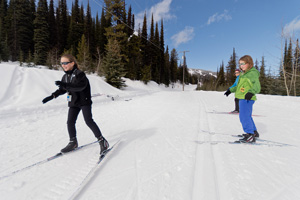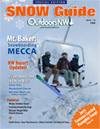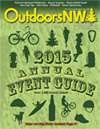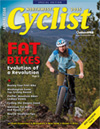Health Nut: Cross-country Skiing for Fitness

By Kelly Turner
Photo at right: Skate-ski lessons at Silver Star, B.C. Photo by Dane Doerflinger
Downhill skiing is fun and all, but with gravity’s help, the slopes end up doing most of the work. Staying horizontal while skiing flat backcountry means it’s all on you to propel yourself forward, making cross-country skiing not only a killer cardio workout, but full-body toning as well.
If you’ve never stepped foot in a ski, touring on flat terrain is actually a pretty good place to start. There is minimal risk of injury, not much of a learning curve and you can do it anywhere there is snow. If you do need extra instruction, many ski resorts offer lessons where you can learn the techniques.
Gear to Get You Going
Equip yourself with the right skis, boots, poles and insulated (but breathable) layers of clothing. Cross-country skiing uses skis with bindings that only affix the ball of the shoe to the ski, leaving the heel free, so you can slide along flat terrain with the aid of ski poles.
There are two types of cross-country skiing: ski touring (long, slow trips) and skate skiing (short, fast-paced runs), and depending on which you choose, you may need slightly different skis, so have an idea of what kind of skiing you will be doing.
Invest in your own equipment if you know you’ll be going out often or rent before you commit. Either way, if you are new to the game, consult a retail professional so you get what you need.
Conditioning Matters
While it might not look like much, cross-country skiing is arguably the most demanding workout you can put your body through. If you’re looking for a leisurely stroll through freshly fallen snow, you’ve got the wrong sport. Cross-country skiing uses just about every muscle in your body and conditioning is necessary.
Start training early with running or biking, working in intervals to strengthen your cardio. The motion of cross-country skiing taxes the arms, specifically the shoulders and triceps, but the core is really where the power comes from.
Pre-condition with planks and side planks to target the deep girdle and ab, and use lower-back exercises for the surface muscles.
Ready, Set, Go!
Practice finding your rhythm and maintaining it, even as you tire out.
Cross-country skiing is about all your muscles working together rather than one muscle group carrying the whole load. Once you’ve got that down, you can start tackling speed and power.
Work in intervals of 80–90 percent maximum effort, followed by shorter recovery periods of 30–35 percent. The interval lengths will depend on your starting fitness level, but aim to push yourself for at least half a mile during your maximum effort intervals for beginners and a mile for seasoned skiers.
This snowy season, let your alpine skis relax back at the lodge and give cross-country skiing a try.
Kelly Turner is a Seattle-based ACE certified personal trainer and fitness writer. You can contact her at KellyTurnerFitness@gmail.com.
Twitter: @KellyTurnerFit
Instagram: KellyTurner26.
Miss a column?
Log onto www.OutdoorsNW.com and search Health Nut.
Fun Fact: The U.S. Cross-Country Ski Team named the Methow Valley in north-central Washington as one of its top choices for skiing in the country. With more than 120 miles of trails through the eastern slope of the Cascade Mountains, it’s a must-do.



